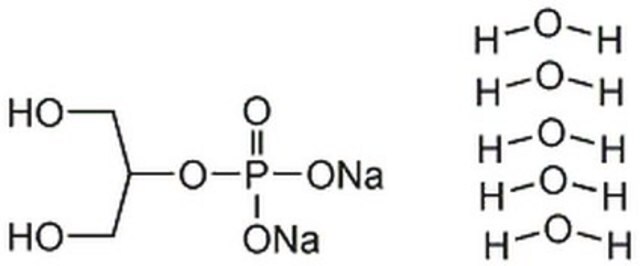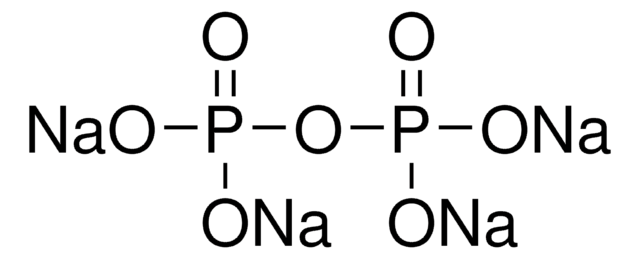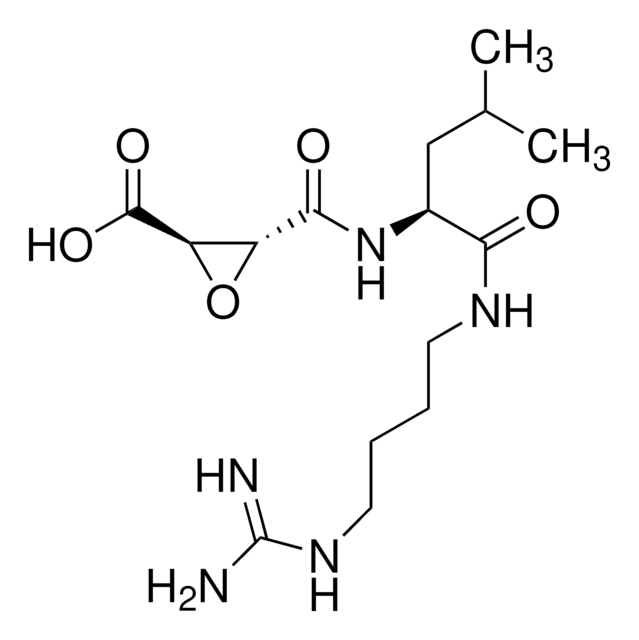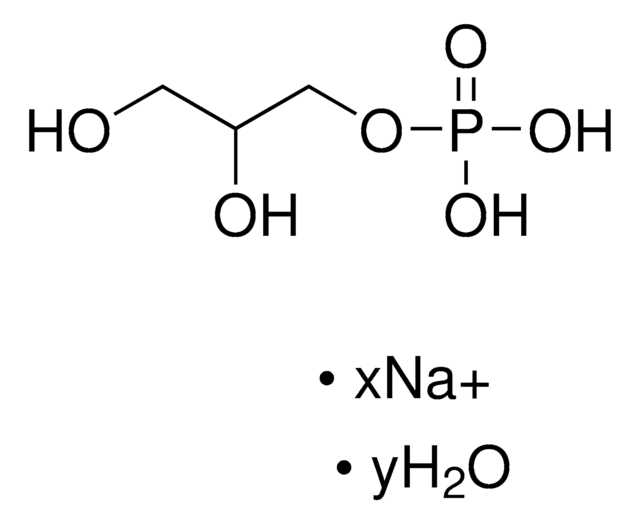G9422
β-Glycerophosphate disodium salt hydrate
BioUltra, suitable for cell culture, suitable for plant cell culture, ≥99% (titration)
Synonym(s):
BGP, Glycerol 2-phosphate disodium salt hydrate
About This Item
Recommended Products
biological source
synthetic (chemical)
Quality Level
product line
BioUltra
assay
≥99% (titration)
form
powder
technique(s)
cell culture | mammalian: suitable
cell culture | plant: suitable
impurities
≤0.1% Insoluble matter
≤0.5 mol % L-α-isomer
color
white
mp
102-104 °C (lit.)
solubility
water: soluble
anion traces
chloride (Cl-): ≤0.05%
sulfate (SO42-): ≤0.05%
cation traces
Al: ≤0.001%
Ca: ≤0.001%
Cu: ≤0.0005%
Fe: ≤0.001%
K: ≤0.005%
Mg: ≤0.0005%
Pb: ≤0.001%
Zn: ≤0.0005%
SMILES string
O.[Na+].[Na+].OCC(CO)OP([O-])([O-])=O
InChI
1S/C3H9O6P.2Na.H2O/c4-1-3(2-5)9-10(6,7)8;;;/h3-5H,1-2H2,(H2,6,7,8);;;1H2/q;2*+1;/p-2
InChI key
ROPZSVKNEIIIDE-UHFFFAOYSA-L
Looking for similar products? Visit Product Comparison Guide
General description
In cell biology, β-Glycerophosphate disodium salt plays a pivotal role as a phosphate group donor in matrix mineralization studies and accelerates calcification in vascular smooth muscle cells. It also promotes bone matrix mineralization when delivered to osteoblasts, providing a crucial source of phosphate ions. In the realm of biochemical research, BGP functions as a classical serine-threonine phosphatase inhibitor in kinase reaction buffers, offering broad-spectrum inhibition. Its role as an organic phosphate donor is particularly valuable in culture media for mesenchymal stem cell differentiation to osteoblast-type cells. Moreover, BGP is utilized to buffer M17 media for Lactococcus culture in recombinant protein expression. The comprehensive utility of BGP spans multiple areas of research, making it an essential component in studies encompassing cell biology, biochemical research, and metabolomics.
Application
Features and Benefits
- Versatile and adaptable for a wide variety of laboratory and research applications
- Suitable for Cell culture and Plant cell culture
- Tested to confirm low levels of heavy metal contamination, ensuring suitability for various applications
- BioUltra Grade for your Cell Biology and Biochemical research
Quality
Other Notes
Not finding the right product?
Try our Product Selector Tool.
comparable product
signalword
Warning
hcodes
Hazard Classifications
Eye Irrit. 2
Storage Class
11 - Combustible Solids
wgk_germany
WGK 3
flash_point_f
Not applicable
flash_point_c
Not applicable
Certificates of Analysis (COA)
Search for Certificates of Analysis (COA) by entering the products Lot/Batch Number. Lot and Batch Numbers can be found on a product’s label following the words ‘Lot’ or ‘Batch’.
Already Own This Product?
Find documentation for the products that you have recently purchased in the Document Library.
Customers Also Viewed
Our team of scientists has experience in all areas of research including Life Science, Material Science, Chemical Synthesis, Chromatography, Analytical and many others.
Contact Technical Service










